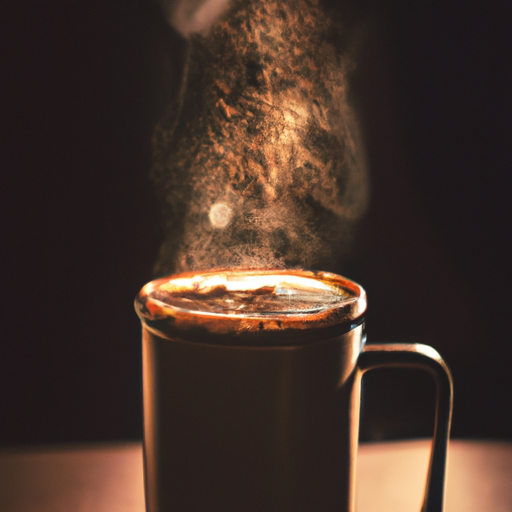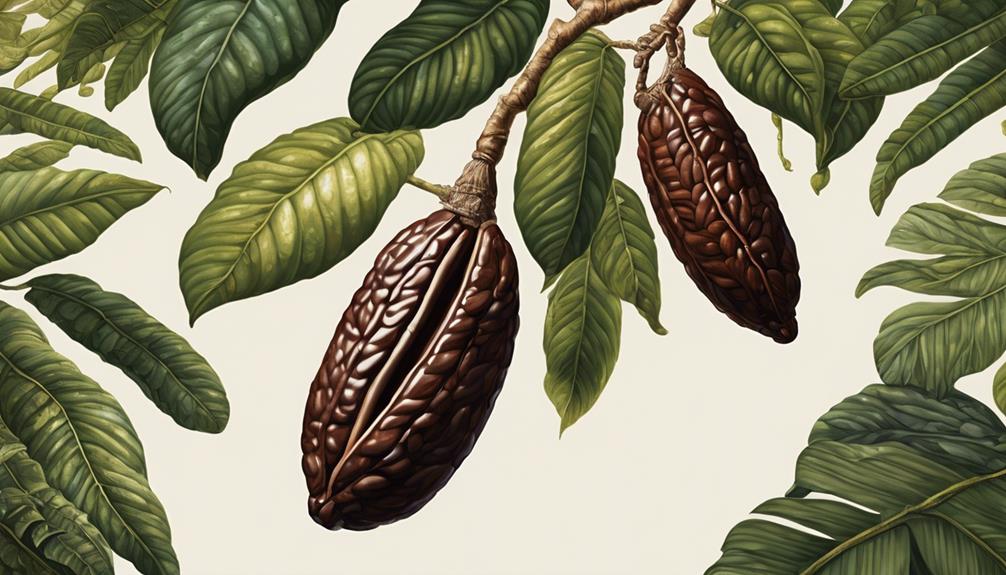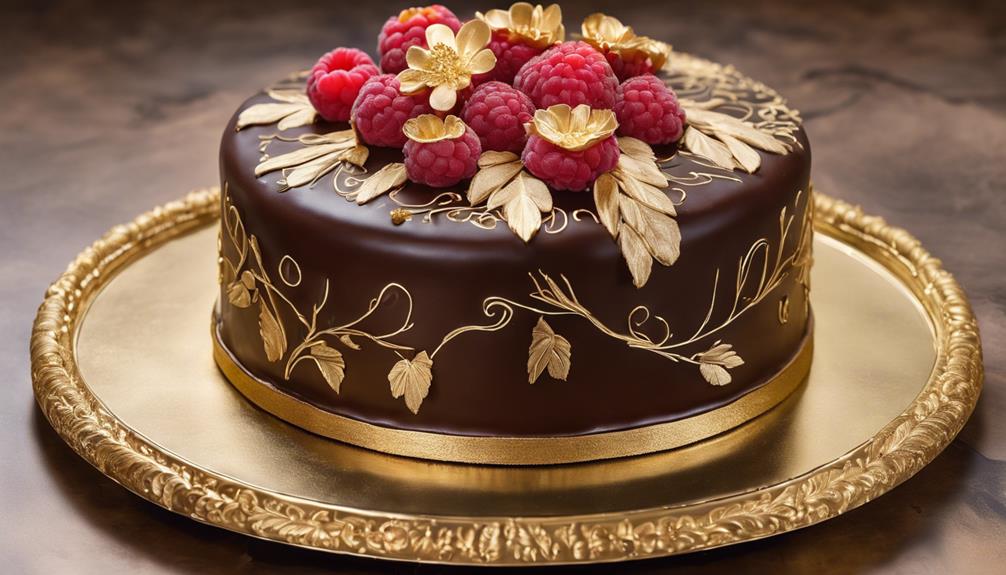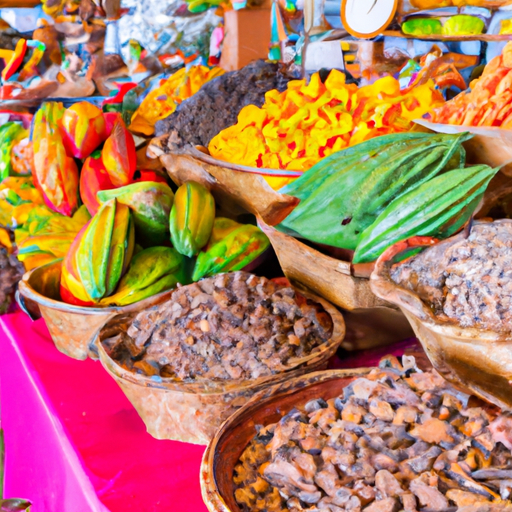I recall the initial experience of tasting a raw cacao powder beverage. Initially doubtful, I thought it would taste bitter and unappealing. However, after just one sip, I was captivated. The decadent chocolatey taste, paired with the multitude of health advantages, made it a beverage I simply couldn’t resist.
That’s why I’m excited to share with you all the ways you can incorporate raw cacao powder into your daily routine.
In this article, we’ll explore the various health benefits of raw cacao powder and how to choose the right one for your needs. We’ll also dive into creating a basic raw cacao powder drink and explore different variations to suit your taste. Plus, we’ll discover how to incorporate raw cacao powder into smoothies, shakes, hot chocolate, and even desserts.
So whether you’re a chocolate lover looking for a healthier alternative or simply curious about the wonders of raw cacao powder, let’s embark on this delicious and nutritious journey together.
Key Takeaways
- Raw cacao powder is rich in antioxidants, magnesium, iron, and fiber, making it a healthy choice.
- Consuming raw cacao powder can improve heart health, reduce inflammation, enhance brain function, boost energy levels, promote digestion, and elevate mood.
- When choosing raw cacao powder, opt for organic options to ensure the highest quality and consider factors such as sourcing, processing methods, and certifications.
- To make a basic raw cacao powder drink, mix it with hot water or milk, and enhance the taste by adding sweeteners like honey, stevia, or vanilla extract.
The Health Benefits of Raw Cacao Powder
Did you know that drinking raw cacao powder can provide numerous health benefits?
Raw cacao powder is packed with essential nutrients, making it a great addition to your daily routine. It is rich in antioxidants, which help fight off free radicals and protect your cells from damage.
Additionally, raw cacao powder is a good source of magnesium, iron, and fiber, all of which are important for overall health. Consuming raw cacao powder has been linked to improved heart health, reduced inflammation, and enhanced brain function.
Incorporating this superfood into your diet can boost your energy levels, promote better digestion, and even elevate your mood. So, if you’re looking to reap these health benefits and improve your overall well-being, consider adding raw cacao powder to your daily routine.
Now, let’s move on to choosing the right raw cacao powder.
Choosing the Right Raw Cacao Powder
When selecting the perfect raw cacao powder for your indulgent beverage, imagine yourself carefully examining the various options at the store, searching for the finest, richest, and most flavorful choice. It’s important to choose organic cacao powder to ensure you’re getting the highest quality and avoiding any potential harmful additives or pesticides. When comparing different cacao powder brands, consider factors such as the sourcing of the cacao beans, the processing methods used, and any certifications they may have, such as Fair Trade or USDA Organic. To help you visualize the differences between brands, here is a comparison table:
| Brand | Sourcing | Processing Methods | Certifications |
|---|---|---|---|
| Brand A | Direct from farmers | Cold-pressed | USDA Organic, Fair Trade |
| Brand B | Ethically sourced | Stone-ground | Fair Trade |
| Brand C | Single-origin | Fermented | None |
By carefully considering these factors, you can find the perfect raw cacao powder that suits your taste preferences and ethical values. Now, let’s move on to the next section and learn how to create a basic raw cacao powder drink.
Creating a Basic Raw Cacao Powder Drink
When creating a basic raw cacao powder drink, I like to start by mixing the powder with either hot water or milk. This helps to dissolve the powder and create a smooth and creamy texture.
Next, I add my preferred sweeteners and flavorings such as honey, stevia, or vanilla extract to enhance the taste. These additions not only add a touch of sweetness but also complement the rich and intense flavor of raw cacao.
Mixing Raw Cacao Powder with Hot Water or Milk
To create a rich and indulgent beverage, simply mix raw cacao powder with steaming hot milk or water. The versatility of raw cacao powder allows for endless possibilities in creating delicious drinks. Here are some ways you can incorporate it into your daily routine:
- Mix raw cacao powder with cold beverages like smoothies or milkshakes for a refreshing and nutritious treat.
- Sprinkle a tablespoon of raw cacao powder over your morning oatmeal or yogurt to add a chocolatey twist to your breakfast.
- Combine raw cacao powder with hot coffee or tea for a delightful mocha flavor.
- Blend raw cacao powder with warm almond milk and a dash of cinnamon for a comforting and healthy hot chocolate alternative.
By experimenting with different combinations, you can find the perfect raw cacao powder drink that suits your taste buds.
Now, let’s move on to the next section where we explore adding sweeteners and flavorings like honey, stevia, and vanilla extract to enhance the flavor even more.
Adding Sweeteners and Flavorings (Honey, Stevia, Vanilla Extract)
Enhance your indulgent beverage with the irresistible sweetness of honey, the natural goodness of stevia, or the aromatic allure of vanilla extract. Sweetening options and alternative flavorings can take your raw cacao powder drink to the next level. Here are some options to consider:
-
Honey: Add a spoonful of honey to your drink for a natural and rich sweetness. Not only does it enhance the flavor, but honey also offers potential health benefits due to its antioxidant properties.
-
Stevia: If you prefer a low-calorie option, stevia is an excellent choice. This natural sweetener derived from the stevia plant adds sweetness without the added calories or sugar.
-
Vanilla Extract: For a touch of sophistication, add a few drops of vanilla extract. It adds a subtle but delightful aroma that complements the rich taste of raw cacao.
By experimenting with different sweetening options and flavorings, you can create unique variations of your raw cacao powder drink. So, let’s explore the endless possibilities and discover your perfect blend of flavors.
Exploring Different Variations of Raw Cacao Powder Drinks
Try experimenting with various ingredients to create unique and delicious raw cacao powder drinks. When it comes to exploring unique flavor combinations, the possibilities are endless.
You can add a hint of cinnamon for a warm and spicy twist or a dash of chili powder for a kick of heat.
Another option is to experiment with different serving temperatures. While a hot cup of raw cacao powder drink can be soothing and comforting, a chilled version can be refreshing and invigorating.
Don’t be afraid to think outside the box and try new combinations.
The next section will delve into incorporating raw cacao powder into smoothies and shakes, providing even more ways to enjoy this versatile ingredient.
Incorporating Raw Cacao Powder into Smoothies and Shakes
When it comes to incorporating raw cacao powder into smoothies and shakes, there are two key points to consider:
-
Blend it with frozen fruits and vegetables: By blending raw cacao powder with frozen fruits and vegetables, you not only enhance the flavor and nutritional value of your smoothie, but also create a refreshing and satisfying drink. This combination adds a natural sweetness and a variety of vitamins and minerals to your beverage.
-
Add protein powders or nut butters: To achieve a creamier texture in your smoothie or shake, consider adding protein powders or nut butters. This not only adds richness and depth to the flavor, but also provides an extra boost of protein. Protein powders and nut butters can help make your smoothie more filling and nourishing, making it a great option for a post-workout snack or a meal replacement.
Remember, experimenting with different combinations and ratios of ingredients is key to finding the perfect balance of flavors and textures in your smoothies and shakes. So don’t be afraid to get creative and enjoy the benefits of incorporating raw cacao powder into your favorite blended beverages.
Blending Raw Cacao Powder with Frozen Fruits and Vegetables
To create a nutritious and delicious smoothie, start by blending raw cacao powder with a mix of frozen fruits and vegetables. Some great options include bananas, spinach, and blueberries.
Raw cacao powder is a fantastic addition to smoothies. It adds a rich chocolate flavor and is packed with antioxidants.
If you’re lactose intolerant or prefer dairy alternatives, try blending raw cacao powder with almond milk or coconut milk. This will create a creamy and flavorful base for your smoothie.
In addition to smoothies, raw cacao powder can be incorporated into breakfast recipes like overnight oats or chia pudding. These recipes provide a healthy and energizing start to the day.
To take your smoothie to the next level, consider adding protein powders or nut butters. These will not only give your smoothie a creamier texture but also provide added nutrients.
Adding Protein Powders or Nut Butters for a Creamier Texture
To achieve a creamy and indulgent texture in your smoothie, consider adding protein powders or nut butters. Here are four alternatives to protein powder and substitutions for nut butter that you can try:
-
Greek yogurt: This tangy and creamy yogurt is packed with protein and will give your smoothie a rich texture.
-
Silken tofu: If you prefer a plant-based protein option, silken tofu is a great choice. It blends well and creates a silky smooth consistency.
-
Hemp seeds: These tiny seeds not only provide a complete source of protein but also add a nutty flavor to your smoothie.
-
Almond butter: Made from ground almonds, almond butter adds a creamy and slightly sweet taste to your smoothie.
Incorporating these protein powder alternatives and nut butter substitutions will help you achieve a satisfying and velvety smoothie. If you’re in the mood for a warm treat, stay tuned for the next section on making raw cacao powder hot chocolate.
Making Raw Cacao Powder Hot Chocolate
Indulge in the rich and velvety goodness of homemade hot chocolate made with raw cacao powder. Making raw cacao powder hot drinks is a simple and delicious way to enjoy the benefits of this superfood.
To create a creamy and decadent hot chocolate, start by heating your favorite milk or dairy-free alternative in a saucepan over medium heat. Once warm, add a tablespoon or two of raw cacao powder and stir until fully dissolved.
For a touch of sweetness, you can add a natural sweetener like honey or maple syrup. To take it up a notch, try incorporating raw cacao powder into your coffee for a mocha-like experience.
The possibilities are endless when it comes to creating raw cacao powder desserts and treats that will satisfy your sweet tooth without compromising your health.
Creating Raw Cacao Powder Desserts and Treats
When it comes to baking with raw cacao powder, the possibilities are endless. I’ve found that adding it to brownies, cookies, and cakes not only enhances the flavor but also provides a rich and decadent taste.
Additionally, I’ve discovered that making raw cacao powder energy balls or truffles is a great way to satisfy my sweet tooth while also providing a boost of energy.
Overall, incorporating raw cacao powder into desserts and treats is a delicious and nutritious way to indulge in something sweet.
Baking with Raw Cacao Powder (Brownies, Cookies, Cakes)
One delicious way to incorporate raw cacao powder into your baking is by adding it to brownie, cookie, or cake recipes. Here are five ways you can use raw cacao powder to elevate your baked goods:
- Mix raw cacao powder into the batter for decadent brownies that have a rich chocolate flavor.
- Replace regular cocoa powder with raw cacao powder in cookie recipes for a more intense and complex taste.
- Add a tablespoon or two of raw cacao powder to your cake batter to create a luxurious chocolate cake.
- Sprinkle raw cacao powder on top of your baked goods before serving for a beautiful and delicious finishing touch.
- Experiment with adding raw cacao powder to pancake or ice cream recipes for a delightful twist on classic treats.
With these baking ideas, you can enjoy the benefits of raw cacao powder in a variety of desserts.
Next, let’s explore making raw cacao powder energy balls or truffles.
Making Raw Cacao Powder Energy Balls or Truffles
Get ready to experience a burst of irresistible flavor as you dive into the world of homemade raw cacao powder energy balls or truffles. These delightful treats are not only delicious, but also packed with nutrients and energy-boosting properties.
Making raw cacao powder energy balls or truffles is incredibly easy. Simply mix together raw cacao powder, dates, nuts, and any other desired ingredients in a food processor. Roll the mixture into bite-sized balls or shape them into truffles.
For an added protein boost, consider incorporating raw cacao powder into homemade protein bars. You can also sprinkle raw cacao powder into your homemade granola for a rich and chocolatey twist. These treats are perfect for a quick and healthy snack on the go.
Now, let’s explore how raw cacao powder can be used in savory recipes.
Exploring Raw Cacao Powder in Savory Recipes
I love experimenting with raw cacao powder in savory recipes because it adds a unique depth of flavor.
One of my favorite ways to use it is by adding a tablespoon or two to chili or mole sauce. The rich, slightly bitter notes of the cacao powder complement the spices and create a deliciously complex sauce.
Additionally, I’ve found that incorporating raw cacao powder into dry rubs for meat or vegetables adds a subtle earthiness that enhances the overall flavor profile. It’s a simple yet effective way to elevate your dishes and impress your guests.
Adding Raw Cacao Powder to Chili or Mole Sauce
To enhance the flavor of your chili or mole sauce, try incorporating raw cacao powder. Not only does it add depth and complexity to the dish, but it also provides a hint of natural sweetness. The rich and earthy notes of cacao complement the spices in these savory recipes, creating a harmonious balance of flavors. When adding raw cacao powder to your chili or mole sauce, start with a small amount and gradually increase to taste. The table below provides some guidance on how much cacao powder to add based on the quantity of sauce. Remember, a little goes a long way, so start conservatively and adjust according to your preference. Adding raw cacao powder to savory recipes is just one of the many ways to explore the versatility of this ingredient. In the next section, we will discuss using raw cacao powder in dry rubs for meat or vegetables.
Using Raw Cacao Powder in Dry Rubs for Meat or Vegetables
Using raw cacao powder in dry rubs for meat or vegetables is a fantastic way to add depth and richness to your dishes. It may sound unconventional, but trust me, it’s worth a try. The bitterness and complexity of the cacao powder add a unique flavor profile that pairs perfectly with smoky grilled meats or roasted vegetables.
To make a delicious dry rub, simply combine raw cacao powder with your favorite spices like paprika, cumin, garlic powder, and chili powder. Massage the mixture onto your meat or vegetables and let it sit for a while to allow the flavors to penetrate. Then, grill or roast as usual for a mouthwatering meal that will leave your taste buds begging for more.
Now, let’s move on to some handy tips for storing and using raw cacao powder.
Tips for Storing and Using Raw Cacao Powder
When storing raw cacao powder, it’s important to keep it in an airtight container to prevent moisture from affecting its quality. Some may argue that it’s not necessary if the powder is used up quickly. Proper storage ensures that the cacao powder retains its flavor and nutritional benefits for longer periods.
Here are three tips for storing and using raw cacao powder:
-
Keep it in a cool, dark place: Heat and light can degrade the quality of the powder. So, it’s best to store it in a cool pantry or cupboard away from direct sunlight.
-
Seal it tightly: To prevent moisture and air from getting in, make sure the container is tightly sealed. This will help preserve the rich flavor and aroma of the cacao powder.
-
Use it in various recipes: Raw cacao powder is versatile and can be used in a variety of recipes like smoothies, baked goods, and desserts. Experiment with different recipes to fully enjoy its rich taste and health benefits.
By following these storage tips and incorporating raw cacao powder into your recipes, you can enhance your culinary creations with its unique flavor and reap its numerous health benefits.
Frequently Asked Questions
Can raw cacao powder be used as a substitute for cocoa powder in baking recipes?
Yes, raw cacao powder can be used as a substitute for cocoa powder in baking recipes. It has a richer flavor and more nutritional benefits, such as higher antioxidants and minerals.
Can raw cacao powder be used in savory dishes like chili or mole sauce?
Yes, raw cacao powder can definitely be used in savory dishes like chili or mole sauce. It adds a rich, deep flavor and also provides the health benefits of cacao powder in savory recipes.
Is there a recommended daily serving size of raw cacao powder for maximum health benefits?
The recommended daily intake of raw cacao powder for maximum health benefits is around 1-2 tablespoons. Consuming this amount can provide antioxidants, flavonoids, and minerals that support heart health and improve mood.
What is the difference between raw cacao powder and regular cocoa powder?
Oh, the difference between raw cacao powder and regular cocoa powder is like night and day! Raw cacao is minimally processed, preserving its antioxidants and nutrients for maximum health benefits.
Can raw cacao powder be mixed with other superfoods for an even more nutritious drink?
Yes, raw cacao powder can be mixed with other superfoods to create a more nutritious drink. Combining it with ingredients like bananas, almond milk, and chia seeds can enhance the raw cacao powder benefits and provide a delicious, nutrient-packed beverage. There are various raw cacao powder recipes available to try.
What are the Different Ways to Use Raw Cacao Powder in a Drink?
Raw cacao powder is a versatile ingredient that adds a rich chocolaty flavor to drinks. Start your day with a nutritious twist by incorporating it into smoothies or mixing it into your morning coffee. To satisfy your sweet tooth, whip up a decadent hot chocolate or indulgent chocolate milkshake using cacao powder. For a refreshing twist, create a cacao-infused iced coffee or a chilled cacao smoothie. Experiment with different combinations and enjoy the delightful taste of cacao in your favorite beverages. Discover how to use cacao powder to elevate your drink experience.
Conclusion
So there you have it, folks! Incorporating raw cacao powder into your daily routine can be a game-changer for your health and taste buds.
From creating basic raw cacao powder drinks to indulging in decadent raw cacao powder desserts, the possibilities are endless.
Don’t forget to explore the savory side of raw cacao powder in your recipes too!
Just remember, when it comes to storing and using this magical ingredient, keep it in a cool, dry place and use it within a year for maximum flavor.
So go ahead, embrace the power of raw cacao powder and let it take your culinary adventures to new heights! Cheers to a chocolaty journey like no other!










